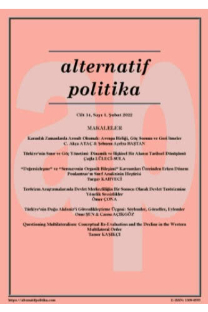THE EMERGENCE OF RIO DE JANEIRO’S MUSLIM COMMUNITY IN THE CITY’S PUBLIC SPACE
Arab migrants –mostly Palestinian, Lebanese and Syriancompose the majority of Muslims in Brazil. Until the beginning of the 21st century, the Islamic institutions present in the country are mainly concerned with the transmission of Islam as a cultural heritage to their descendants. Rio de Janeiro’s Muslim community presents a particularity since, in the beginning of the 1990s, it’s Islamic Mutual-Aid Association discontinues the transmission of Islam as an Arab religion, separating religion and culture, thus making Islam accessible to the Brazilian public. This leads to an important increase in the number of Muslims in Rio, as well as the construction of the city’s only operational mosque in 2007. Exemplary, this case sheds light on the ways a new religious actor emerges in the religious urban landscape of the city. This essay examines the emergence of Rio de Janeiro’s Muslim community in the urban and public space of the city.
___
Baeza, Cecilia (2017), “Between Indifference and the Charity: the Syrian Diaspora and Syrian refugees in Brazil”, Policy Alternatives, available on http://www.arab-reform.net/en/node/1068.Bozarslan, Hamit (2005), 100 mots pour dire la violence dans le monde musulman (Paris : Maisonneuvre).
Corbin, Alain (2000), Les Cloches de la terre Paysage sonore et culture sensible dans les campagnes au XIXe siècle, Flammarion, Paris, 2000 (1st ed. 1994).
Dias, Amanda S. A. (2011) The Islamic presence in Brazil and in Rio de Janeiro. Global Prayers – Redemption and Liberation in the City. Retrieved from: http://globalprayers.info/about-us/fellows/amanda-dias/islamic-presence-inbrazil-and-rio-de-janeiro.
Dias, Amanda S. A. (2013), “Beyond the city: experiences of Muslim cariocas”, J. Becker, K. Klingan, S. Lanz & K. Wildner (Eds.), Global Prayers. Contemporary Manifestations of the Religious in the City (Berlin: Lars Müller): 494-513.
Furseth, Inger (2011), “Why in the City? Explaining Urban Fundamentalism”, N. AlSayyad & M. Massoumi (Eds.), The Fundamentalist City? Religiosity and the remaking of urban space (London: Routledge): 27-50.
Garrioch, David (2003), “Sounds of the city: the soundscape of early modern European towns”, Urban History, 30: 5-25.
Geertz, Clifford (1983), Local Knowledge: Further Essays in Interpretive Anthropology (New York: Basic Books).
Hajjar, Claude Fahd (1985), Imigração árabe: 100 anos de reflexão (São Paulo: Editora Cone).
Hervieu-Leger, Danièle (2002), “Space and religion: new approaches to religious spatiality in modernity”, International Journal of Urban and Regional Research 26 (1): 99–105.
Mello Santos, Alexandre, Márcia Pereira Leite and Nahyda Franca (2003), Quando memória e história se entrelaçam: a trama dos espaços na Grande Tijuca (Rio de Janeiro: Ibase).
Montenegro, Silvia (2000), Dilemas Identitários do Islam no Brasil - A comunidade muçulmana sunita do Rio de Janeiro (PhD dissertation, Rio de Janeiro: IFCS/UFRJ).
Montenegro, Silvia (2002a), “Discursos e contradiscursos : o olhar da mídia sobre o Islã no Brasil”, Mana, 8 (1): 63-91.
Montenegro, Silvia (2002b), “Identidades muçulmanas no Brasil: entre o arabismo e a islamização”, Lusotopie 2002/2: 59-79.
Montenegro, Silvia (2004), “Telenovela et Identités Musulmanes au Brésil”, Lusotopie, XI (1): 243-261.
Orsi, Robert A. (Ed.) (1999), God’s of the City. Religion and the American Urban Landscape (Indiana University Press).
Oosterbaan, Martijn (2006), Divine Mediations. Pentecostalism, Politics and Mass Media in a Favela in Rio de Janeiro, (PhD. Dissertation, Amsterdam: University of Amsterdam).
Peres, Vitória (2006), “Islam in Brazil or the Islam of Brazil?”. Translation from Religião e Sociedade, 26 (1) : 83-114.
Pinto, Paulo (2005) “Ritual, etnicidade e identidade religiosa nas comunidades muçulmanas no Brasil”, Revista USP, São Paulo, 67: 228-250.
Pinto, Paulo (2010), “Novos espaços do Islã: Comunidades Muçulmanas na Europa e no Brasil” p. 195-219 In Islã: Religião e Civilização. Uma abordagem antropológica, São Paulo: Editora Santuário.
Pinto, Paulo 2010b), Arabes no Rio de Janeiro, uma identidade plural (Rio de Janeiro: Editora Cidade Viva).
Pinto, Paulo (2010c), “Muslim identities in Brazil: Shared traditions and Cultural Creativity in the Making of Islamic Communities”, Paper prepared for the Islam in Latin America Workshop, Florida International University, Applied Research Center, April 2010.
Pinto, Paulo (2013), “Islã em números: os muçulmanos no Censo Demográfico de 2010”, F. Teixeira & R. Menezes (Eds.), Religiões em movimento: o Censo de 2010 (Petrópolis: Vozes).
Reis, J. J. A (2003), 1986, Rebelião escrava no Brasil: a história do Levantes dos Malés (1835). 1986. (São Paulo: Companhia das Letras)
Rodrigues, Nina (2004), Os Africanos no Brasil (Brasília: UNB [1906]).
Roy, Olivier (2002), L’Islam mondialisé (Paris: Editions du Seuil).
Rustom, Joseph (2011), “Conceiving Places of Worship in Postwar Beirut. The Cases of al-Omari and al-Amin Mosques. Global Prayers – Redemption and Liberation in the City”, Retrieved from: http://globalprayers.info/aboutus/fellows/joseph-rustom/conceiving-places-of-worship-in-postwar-beirut.
Schafer, Murray (1994), The soundscape: our sonic environment and the tuning of the world (Vermont: Destiny Books).
Truzzi, Oswaldo (1997), Patrícios: sírios e libaneses em São Paulo (São Paulo: Hucitec).
Wilson, Ara (2008), “The Sacred Geography of Bangkok’s Markets”, International Journal of Urban and Regional Research, 2 (3).
Witte, Marlin de (2008), “Accra’s Sounds and Sacred Spaces”, Journal of Urban and Regional Research, 2 (3): 690-709.
- ISSN: 1309-0593
- Yayın Aralığı: Yılda 3 Sayı
- Başlangıç: 2009
- Yayıncı: Rasim Özgür Dönmez
Sayıdaki Diğer Makaleler
THE REAL FUNCTION OF THE “DISASTER LAW” IN THE URBAN DEVELOPMENT OF ISTANBUL
WOMEN AND RESISTANCE IN URBAN SPACE
THE EMERGENCE OF RIO DE JANEIRO’S MUSLIM COMMUNITY IN THE CITY’S PUBLIC SPACE
“CITIES: IDENTITIES, APPROPRIATION OF SPACE AND RESISTANCE PRACTICES”
NEOLİBERAL YENİDEN ÖLÇEKLENME ETKİSİ ALTINDA TÜRKİYE’DE KENTLEŞME POLİTİKASININ DÖNÜŞÜMÜ
